Review of 'Robots: The 500-Year Quest to Make Machines Human'
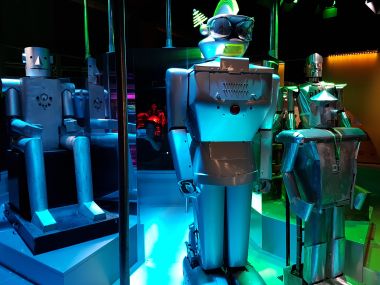 https://beta.sciencemuseum.org.uk/robots/
https://beta.sciencemuseum.org.uk/robots/
Robots are man's attempt at recreating itself and so are often the subject of great fascination. This exhibition has been at the Science Museum since early this year but I only just recently had the opportunity to visit during one of their late night Friday openings.
The exhibit is on the first floor of the Science Museum where you are greeted with a wall with half-head pieces containing robotic eyes that move and seem to follow you as you pass them. Not entirely sure what is being said here but it is neat.
On entering the exhibit itself you are confronted with a baby that looks extremely convincing and life like until you walk around to the side to see that it is indeed mechanical. We were later told that it should actually move and cry (causing the staff at the museum some discomfort when the museum is closed at night) but is broken and despite their best efforts has not yet been repaired. It is still a strong and startling piece that is used in much of the marketing material for the show.
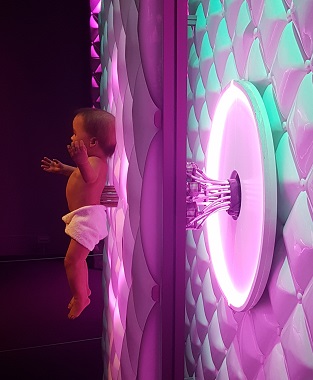
The exhibit is divided into five thematically arranged sections.
Section 1: Marvel
The first section of the exhibit tells the origins of robots in the 16th century where the complexity of watches and clocks causes man to think about whether or not he may be able to duplicate himself. Here there are examples here of clocks and automatons including automated religious icons, early mechanical representations of human anatomy to much more complicated pieces that closely mimic human behaviour.
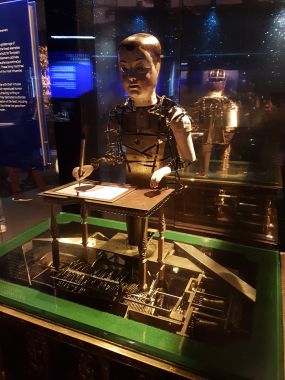
This automaton is able, through the use of an intricate mechanical mechanism, to draw a small selection of tremendously elaborate pictures. A short video shows it in action and is fascinating.
Section 2: Obey
This small section has only a single exhibit of a complicated weaving loom that signals the transition of robots from the subjects of whimsy and possessions of the elite into the practical world of common man as the industrial age was upon us.
Section 3: Dream
This is the most fun of the exhibit sessions where visitors are confronted with “Maria”, the robot from the classic Fritz Lane film Metropolis. There are other robots here from the early twentieth century and often used in films. Indeed, a large display case has various artefacts from this period (to the present) that feature robots, film posters and some robot toys, as well as an original copy of Karel ÄŒapek's play R.U.R. (Rossum's Universal Robots) written in 1920.
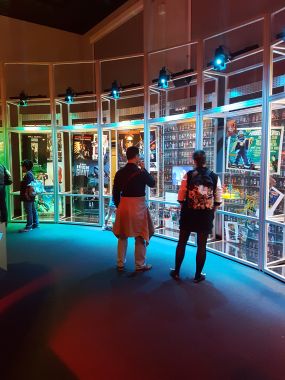
In another alcove is one of the robots from the Terminator movies bringing us bang up to date.
Section 4: Build
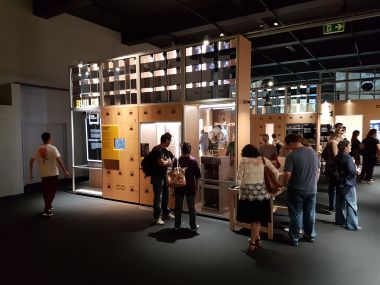
Here we see the research currently taking place (and historically) into the the modern robot. Along the walls are samples of this research including sections devoted to specific functions such as walking, dexterity (hands), and vision. The middle of the room is dominated by a large circular area in which stands a tall robot with a video screen showing what it is seeing on it's chest as he shifts his focus on visitor's faces, often unnoticed, and reacting with occasional movement.

On our visit there was a member of the museum staff on hand allowing visitors to interact with a dog robot and a cat robot. The cat in particular would start purring when pet and roll over to let you scratch it's belly. They were both eerily real in their behaviour yet so obviously artificial when touched.
Section 5: Imagine
“Imagine” is the world of today with a series of alcoves on either side of the room containing examples of mostly autonomous robots that are in use today, both for industrial and entertainment purposes.
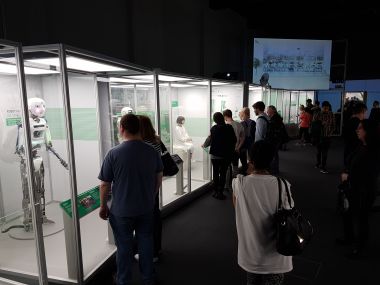
There are a number of highlights here, a “thespian” robot that moves and talks quite eloquently; a small child-like robot that tells stories and with whom you can interact (“put your hands on top of mine”); an industrial robot arranging small blocks in the world it “sees” around it; two robots that are made to not look TOO human that are used for therapy with autistic children; a creepy amorphously shaped robot used for telepresence (used for communication with remote callers, their voice and movements reflected in the local device); another couple of industrial robots used in manufacturing demonstrating incredible range of movement and dexterity.
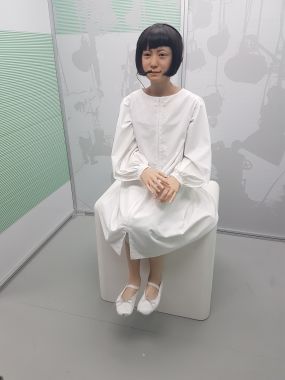 Kodomoroid communication android by Osaka University and ATR Laboratories, Japan, c. 2014
Kodomoroid communication android by Osaka University and ATR Laboratories, Japan, c. 2014
This was the most popular section as visitors with many of the robots actually doing something and interacting with visitors. Amazing to see how far we have come.
The exhibit exit (somewhat cynically) lands you in the shop selling loads of souvenirs and a small eating area.
My thoughts
The focus on this exhibit was on the history of humans attempting to recreate the intricacy of human body function. No moral judgements are passed here as we are simply shown the exhibits and take them in. Visitors are encouraged to simply experience more child-like wonder with the incredible things on display here. It is very good to see not only these amazing pieces but also to interact with them. Ironically, in the “Build” section research into human behaviour towards these creations are being explored using robots specifically designed to study the humans that interact with them. I think here sitting back and watching visitors you could learn a lot as it demonstrates our fascination with these mechanical marvels.
A very interesting and fairly comprehensive exhibit that has a great sense of fun and is most definitely not boring. Certainly worth paying and seeing before it closes on September 3rd.
Rating: “I have absolutely no complaints”
Review Date: 2017-08-18
Science Museum
Location: London (England)
Address: The Science Museum Exhibition Road South Kensington SW7 2DD ENGLAND
Public Transport:  South Kensington
South Kensington
URL: http://www.sciencemuseum.org.uk/
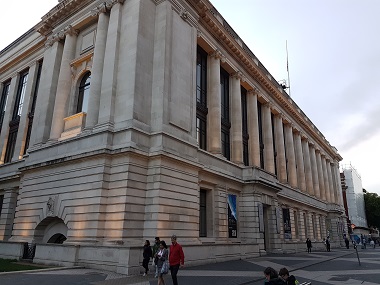 One of the great, free, museums in London. The Science Museum provides a lot of great hands-on exhibits in a magnificent set of exhibit halls. There is a charge for special exhibits and tickets to their IMAX theatre. It is easy to get to with the tube station only minutes away (and accessible via a pedestrian tunnel beneath the street). You can also walk through the Science Museum into the Natural History Museum.
One of the great, free, museums in London. The Science Museum provides a lot of great hands-on exhibits in a magnificent set of exhibit halls. There is a charge for special exhibits and tickets to their IMAX theatre. It is easy to get to with the tube station only minutes away (and accessible via a pedestrian tunnel beneath the street). You can also walk through the Science Museum into the Natural History Museum.